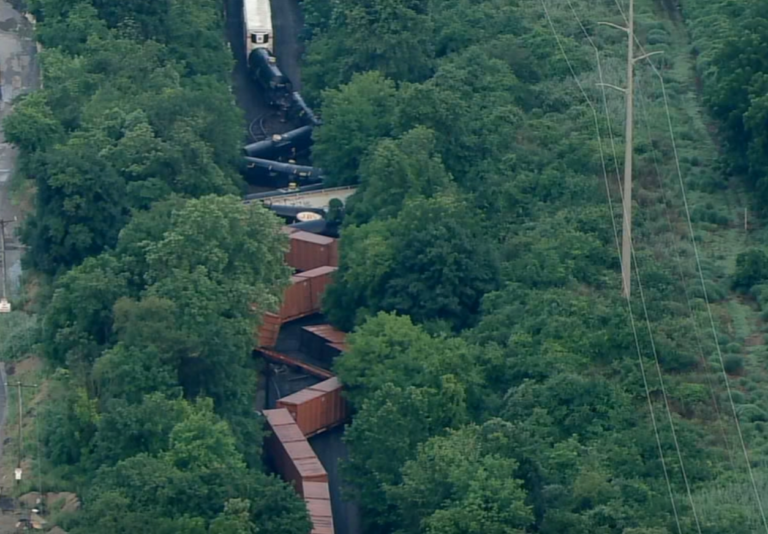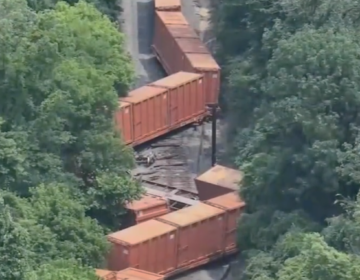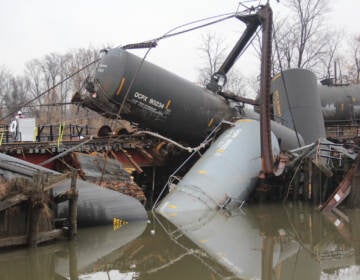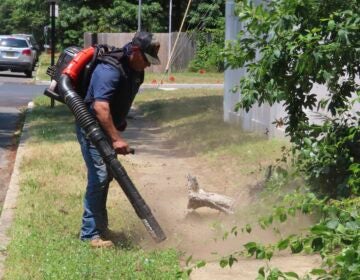Whitemarsh train derailment labeled ‘wakeup call’ by rail safety advocates
Advocates are calling for stricter rail safety measures, increased transparency, and improved emergency preparedness in the event of train derailments.

The scene of a train derailment in Montgomery County. (6abc)
Transportation experts and environmental advocates are calling for increased rail safety following Monday’s train derailment in Whitemarsh Township, Montgomery County.
The CSX train, traveling on Norfolk Southern tracks, carried flammable Liquefied Petroleum Gas (LPG), as well as a toxic chemical commonly used as a dry cleaning agent. While no leaks of hazardous materials occurred, some are calling the accident a wakeup call.
“Any kind of a derailment like this where there’s disaster-potential chemicals like LPG should be taken as a warning sign that things need to get better,” said Fred Millar, an independent rail consultant with an expertise on hazardous materials.
Norfolk Southern faced scrutiny in February after a train carrying toxic vinyl chloride derailed and caught fire in East Palestine, Ohio. Congress is now considering legislation aiming to increase rail safety.
CSX and Norfolk Southern did not immediately respond to requests for comments.
Millar argues that federal regulators have failed to enact stricter rail safety measures, and that the rail industry has kept the public in the dark about its operations. He calls for an analysis of where trains carrying hazardous materials are routed.
“What if the rail cars had been breached of the most dangerous cargoes?” Millar said. “One thing that people rarely know how to ask is, ‘Why should these cargoes be coming on this particular track at all?’”
One of the roadblocks, he said, is that local and state governments don’t have much authority over train routes. Under Federal Railway Administration rules, railroads are required to use software to determine the safest routes to transport hazardous materials. However, Millar argues rail companies have too much discretion over routes, and aren’t required to share information with the public.
“The fact is, the railroads are so politically powerful that they’ve got federal preemption over state and local officials,” he said.
In fact, lawmakers who have lost battles against the rail industry in the past have voiced concerns that the Ohio incident may not be enough to enact change.
Tracy Carluccio of the Delaware Riverkeeper Network said she agrees it’s important to evaluate train routes — several developments and businesses in Whitemarsh Township are adjacent to the rail tracks, for instance. However, risks can arise in remote areas too, said the environmental activist.
Following Monday’s derailment, silicone pellets leaked onto the tracks. Officials say they are non-hazardous, but Carluccio argues they could be deadly to fish and wildlife.
“If those pellets were to enter a stream, it could suffocate the life that lives there,” she said.
“So whether [a train is] going through an urban area, or whether it’s going past a river where nobody lives, it’s going to have impacts if there’s a derailment.”
Drexel University’s Mathy Stanislaus is an expert on hazardous waste and emergency response. He calls for the rail industry to better disclose the number of derailments and causes, and lay out prevention plans.
Stanislaus said rail companies also should better prepare communities and local responders.
“Make this a public issue where the public has a right to know the hazards in the neighborhood, and how it should be prevented, and if an accident happens, how they can protect themselves,” he said. “When there’s less disclosure, the local communities are less prepared to deal with the potential hazard coming from the incident.”
Following a 2012 train derailment in Paulsboro, New Jersey, the National Transportation Safety Board reported that first responders weren’t prepared for such an emergency.
The NTSB recommended railroad companies transporting hazardous materials be required by the Department of Transportation to help develop emergency operations and response plans in conjunction with the communities they travel through. However, the U.S. Department of Transportation and its Pipeline and Hazardous Materials Safety Administration (PHSMA) have failed to follow through, according to the NTSB.
But last month, PHSMA announced a proposal that would require railroads to provide firefighters electronic information about rail hazmat shipments on a regular basis, as well as during an accident. PHMSA Deputy Administrator Tristan Brown said it would enable first responders to better prepare for hazard risks prior to arriving on the scene of an accident.
CSX said Monday’s train derailment was caused by a sinkhole in the railbed following heavy rain. Stanislaus said he hopes the accident will also lead to studies on the impacts of extreme weather on rail infrastructure.
“We are going to see, as we’ve seen over the last couple of weeks in the Pennsylvania area, severe daily climate [change] related rain events,” he said. “So we need to make sure that the infrastructure can uphold the increased severity of infrastructure.”

Get daily updates from WHYY News!
WHYY is your source for fact-based, in-depth journalism and information. As a nonprofit organization, we rely on financial support from readers like you. Please give today.







